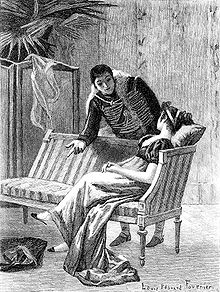La Duchesse de Langeais
 Title page of La Duchesse de Langeais (1833) | |
| Author | Honoré de Balzac |
|---|---|
| Country | France |
| Language | French |
| Series | La Comédie humaine |
Publication date | 1834 |
La Duchesse de Langeais is an 1834 novel by French author Honoré de Balzac (1799-1850) and included in the Scènes de la vie parisienne section of his novel sequence La Comédie humaine. It is part of his 1839 trilogy Histoire des treize: Ferragus is the first part, Part Two is La Duchesse de Langeais and Part Three is The Girl with the Golden Eyes. It first appeared in 1834 under the title Ne touchez pas la hache (Don’t Touch the Axe)[1] in the periodical .
Plot[]
General Armand de Montriveau, a war hero, is enamored of Duchess Antoinette de Langeais, a coquettish, married noblewoman who invites him to a ball but ultimately refuses his sexual advances and then disappears. Assisted by the powerful group known as The Thirteen, who subscribe to an occult form of freemasonry, General Montriveau finds the duchess in a Spanish monastery of Discalced Carmelites under the name of Sister Theresa.
Dedicated to Franz Liszt, this portrait of a vain representative of the noble families of Faubourg Saint-Germain, was inspired by the with whom Balzac had a failed romance.
Film adaptations[]
- , 1910 French film by André Calmettes
- The Eternal Flame, 1922 American film by Frank Lloyd
- Love (Liebe), 1927 German film by Paul Czinner
- La Duchesse de Langeais, 1942 French film by Jacques de Baroncelli
- , 1982 French television film by Jean-Paul Roux
- , 1995 French television film by
- Ne touchez pas la hache, 2007 French film by Jacques Rivette
| Wikisource has original text related to this article: |
References[]
- ^ This expression is a reference to the axe that had been used to decapitate Charles I of England, which the character Montriveau had overheard at Westminster Palace.
- Books of La Comédie humaine
- Novels set in 19th-century France
- 1834 French novels
- French novels adapted into films
- Novels by Honoré de Balzac
- 19th-century novel stubs